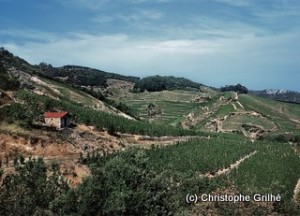Domaine Clape – putting the cor back into Cornas
A shorter version of this article first appeared in Winestate magazine, Sept/Oct 2010.
For the unloved years of decline following the second world war, Auguste Clape was a lone pioneer, benchmark and flag-carrier for the small appellation of Cornas, at the southern end of the northern Rhône, the best of which wines are said to rival those of Hermitage.

Family Clape
It wasn’t until the 1990s that the Cornas star started rising again, with the likes of Jean-Luc Colombo and Thiérry Allemand helping to put the cor back in Cornas. But Domaine Clape remains the appellation’s flag bearer. Having steadfastly held true to the family’s traditional way of making this 100% syrah wine, the reputation of this estate remains impeccable.
Auguste Clape became a grower in Cornas when he married, as his wife’s family owned five hectares in the appellation. Their first vintage was 1949. Forty years later their son Pierre-Marie, then 40 years old, joined Auguste. Now, third generation Olivier, 31 years old, has been ensconced in the family business since 2003, working with his father, while his grandfather, now 85, has at least ostensibly retired.
Nothing is big scale in Cornas, the only one of the northern Rhône appellations to stipulate it must be made solely from syrah. With 116 hectares planted in total, and 40 to 45 wine businesses – negociants, domaines, winemakers – operating, the average plot size is not great. Part of this is because vines are planted on steep, east, south and south-west facing granite slopes and terraces, so everything pretty much needs to be done by hand.
The Clapes own 5.5 hectares, which Olivier said is big enough for a small family “I like to be in and work in the vineyard, and we don’t want to lose the contact with the ground. If you grow too much you have to delegate and then you stay at the office and do a lot of papers, you lose a bit of the real job of winegrowing and making.”
Unusually for Cornas, Olivier’s grandfather started ageing his syrah in foudres. These are 1,200 litre, oval casks, more commonly found in Alsace. Olivier explained “there is a bit less oxygenation in the foudre. It’s maybe more true to the wine, it doesn’t touch the wine too much. My grandfather liked them, so he kept them. They’re probably 50 years old now.”
After this length of time, big old casks can start leaking a bit, so the Clapes have started to replace some of the casks, but still with the foudres. Olivier said “we bought four new foudres in 2004 and 2006.”
But the family does not want the flavour of new oak in their wines, so they send their new foudres to be ‘broken in’ by Domaine Ott in Bandol, southern France. Ott are happy to make a white fermentation in the new foudres. Olivier said “After a year they come here to the winery for the Cornas. And after 4-5 years they are almost neutral. You really can’t taste oak in the wine.”
“We don’t do too much winemaking, we let nature speak”
The foudres are for maturing the new wines. That little bit of oxygenation helps to round out the tannins. The rest of the winemaking is just at traditional, said Olivier “we don’t do too much in the winemaking, we let nature speak. We use 100% whole bunches [no destemming], a little bit crushed before going into cement tanks.” The fermenting must gets a “light punch down and pump over twice a day for 12 days”, but they “always try to get the best maturity in the vineyard, then do very little in the winemaking.”
Using stalks or not in red winemaking is often a point of debate, but Olivier explained “We have a short, for the region, fermentation and maceration, because we don’t want to go too far with the stalks. They give a bit of tannin and also some freshness and acidity. It may make the wine a bit tighter, but it enables the wine to age.” He added if they were to destem, the wine would be heavier, whereas they are looking for elegance and a certain lightness in the naturally full-bodied syrah variety.
Four wines are made by Domaine Clape, all of them made from syrah. Vin des Amis comes from just one hectare of vines that lie outside the appellation. It is now labelled as the new ‘vin de France’ category. The Clapes make it the same way they make their Cornas, with whole bunches, and with a few months’ maturation
Next up is another single hectare of Côtes du Rhône, which also lies outside the Cornas appellation. This has up to 10 months’ maturation.

Cornas
Then two cuvées are made from the 12 different parcels of vineyard they have scattered over the Cornas appellation. Cornas Renaissance is made from young vines “12, 15 and 20 year old vines. The wine is a blend of those different young vineyard parcels” said Olivier, and is the most recent addition to the portfolio – it’s first vintage was 1997. Olivier said this cuvée is more fruity, more exuberant, but it won’t age as long as their top wine.
This top wine, labelled just Cornas, is an old vineyard cuvée, from 30, 50 and 60 year old vineyards, where some individual vines are over 100 years old. As the Clapes replace each vine as it dies, it’s quite tricky to give a precise age of a vineyard parcel. This is the more austere, tight blend, with most structure and complexity, a long palate and long age-worthiness. Both spend up to 20 months maturing. Though the winemaking for the two Cornas blends is the same, what’s being expressed, said Olivier, is the different terroirs.
Top Cornas can be muscular and powerful, and the best retain an elegance, a purity of fragrance balanced with a firm structure. Olivier explained that Cornas “is a wine to be aged. It’s a full bodied wine with structure, and usually you need to know a bit about wine to understand Cornas.”
Of his own wines, he said “we try to make wine with structure and finesse, with fine tannins, as well as fruit. We try to have an elegant wine, with a lot of body and not just big tannins. And the granite gives minerality to the wine.”



